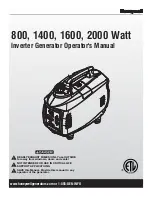
6.3 Entretien électrique
6.3.1 Nettoyant pour les bobinages
Les solvants fortement chlorés et sujets à l' hydrolise en
atmosphère humide sont interdits. Ils s' acidifient rapide-
ment en donnant de l'acide chlorhydrique corrosif et
conducteur.
ATTENTION :
NE PAS UTILISER TRICHLORETHYLENE, PER-
CHLORETHYLENE, TRICHLOROETHANE.
ATTENTION :
NE PAS UTILISER DE PRODUITS ALCALIN. ILS
SONT TRES DIFFICILES A RINCER ET PAR LA ME-
ME REDUIRE LA RESISTANCE DE L'ISOLATION EN
FIXANT L'HUMIDITE.
On peut utiliser des produits dégraissants et volatils purs
bien définis tels que :
- Essence de tourisme ( sans additifs )
- Toluène (faiblement toxique) ; inflammable
- Benzène (ou benzine, toxique) ; inflammable
- Ciclohexaire (non toxique) ; inflammable
6.3.2 Nettoyage des stator, rotor , excitateur et
pont de diodes
a) Utilisation de produits chimiques spécifiques
Les isolants et le système d'imprégnation ne sont pas
sujet à être endommagés par les solvants (voir la liste
des produits autorisés ci-dessus).
Il faut éviter de faire couler le nettoyant vers les
encoches. Appliquer le produit au pinceau en épongeant
souvent pour éviter les accumulations dans la carcasse.
Sécher le bobinage avec un chiffon sec. Laisser
évaporer les traces avant de refermer la machine.
Aprés nettoyage de l' alternateur il est impératif de sé-
cher pour retrouver un niveau d'isolation correct des bo-
binages ( voir le chapitre 7.4 séchage des bobinages).
Contrôler l'isolation pièces froides ( voir chapitre 7.3 ).
b) Rinçage à l'eau propre
Il est possible d'utiliser de l'eau chaude propre ( moins
de 80
°
C ) sous pression ( moins de 20 bars ) pour rincer
la machine.
Aprés nettoyage de l' alternateur il est impératif de sé-
cher pour retrouver un niveau d'isolation correct des bo-
binages ( voir le chapitre 7.4 séchage des bobinages).
Contrôler l'isolation pièces froides ( voir chapitre 7.3 ).
6.3.4 Laquage
Aprés nettoyage et séchage effectués selon les recom-
mandations ci avant, tous les bobinages seront vernis à
l' aide d' un vernis approprié.
ATTENTION :
SANS PREPARATION PREALABLE ET QUEL QUE
SOIT LE VERNIS UTILISE, UN NOUVEAU LAQUAGE
EST A DECONSEILLER, CAR IL EMPRISONNE ET
RETIENT DEFINITIVEMENT LES PARTICULES DE
CARBONE CONDUCTRICES.
21
Alternators
LSA 50-51
Alternateurs
LSA 50-51
6.3 - Electrical maintenance
6.3.1 - Coil-cleaning product
Solvents which are highly chlorinated and subject to hy-
drolysis in damp atmospheres are prohibited. They
quickly become acidified, producing corrosive and con-
ductive hydrochloric acid.
CAUTION :
DO NOT USE TRICHLORETHYLENE, PERCHLO-
RETHYLENE, OR TRICHLORETHANE
CAUTION :
DO NOT USE ALKALINE PRODUCTS. THEY ARE DIF-
FICULT TO RINSE AND THEN ALLOW THE INSULA-
TION RESISTANCE TO DECREASE BY FIXING THE
HUMIDITY.
One can use pure de-greasing and volatile agents which
are well-defined such as :
Gasoline ( without additives)
Toluene (slightly toxic ) ; inflammable
Benzene (or benzine (toxic) ; inflammable
Ciclohexaire (non-toxic); inflammable
6.3.2 - Cleaning the stators, rotors, exciter and diode
bridge
a) Using specific chemical product
The insulating materials and the impregnation system
are not damaged by the solvents (see the list of authoriz-
ed products above).
It is essential to avoid the entry of the cleaning agent into
the slots. Apply the product with a brush, sponging up
frequently in order to avoid accumulation in the housing.
Dry the winding with a dry cloth. Allow the traces to
evaporate before reassembling the machine.
After cleaning the generator, drying is imperative to re-
cover the correct winding insulation ( refer to chapter 7.4
drying the winding ).
Check the electrical insulation when the parts are cold
(see chapter 7.3.).
b) Rinsing using soft water
Hot soft water ( less than 80
°
C ) used under pessure (
less than 20 bars ) can be used.
After cleaning the generator, drying is imperative to re-
cover the correct winding insulation ( refer to chapter 7.4
drying the winding ).
Check the electrical insulation when the parts are cold
(see chapter 7.3.).
6.3.4 Varnishing
A new varnishing is not necessary and it is fully advised
to re-paint the windings with an adequat painting after
cleaning and drying with an above method.
CAUTION :
IN CASE OF CLEANING NOT BY USING ONE OF THE
ABOVE METHOD, PAINTING OR VARNISHING ARE
NOT ADVISED TO AVOID TO AGGLUTINATE THE
CARBON DUST.







































